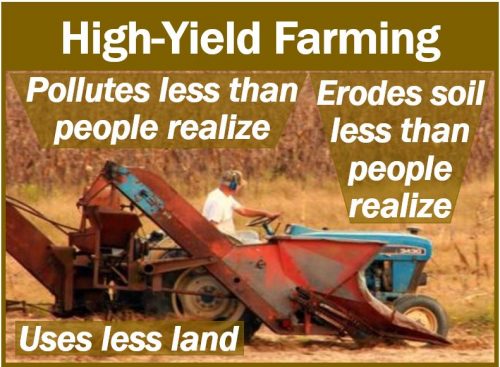High-yield farming uses less land than agriculture that appears to be eco-friendly. It may have lower environmental costs per unit of land than eco-friendly farming, researchers suggest.
High-yield or intensive farming contrasts with traditional farming. Intensive farming involves several types of agriculture with greater levels of input and output per cubic unit of agricultural land area.
Andrew Balmford and colleagues carried out a study on farming methods. They wrote about their study and findings in the journal Nature Sustainability (citation below).
Prof. Balmford is a Professor of Conservation Science from the University of Cambridge’s Department of Zoology.
The study, led by Cambridge scientists, also included researchers from Australia, Colombia, Mexico, Brazil, and Poland.

High-yield farming – global food demand
There is growing evidence that the best way to meet increasing global food demand is to get the highest agricultural yields possible. We also need to do this sustainably. Then, more natural habitats will be ‘spared the plow (UK: plough)’
However, this involves using intensive farming techniques. These techniques, we believe, create disproportionate levels of soil erosion, pollution, and water scarcity.
In this latest study, however, researchers found that this may not necessarily be the case.
The researchers put together measures for fertilizer and water use and greenhouse gas emissions. Specifically, the major ‘externalities’ that high- and low-yield farming systems generate.
Greenhouse gases are atmospheric gasses that absorb and emit radiation. In other words, they keep our planet’s surface warm. There is a global effort to reduce greenhouse gas emissions because they exacerbate global warming.
The researchers then compared the environmental costs of producing a specific amount of food using different farming methods.
Previous studies had compared these costs according to land area. High-yield farming requires less land to produce the same amount of food. The authors say that, therefore, this approach tends to overestimate its environmental impact.
High-yield farming pollutes less
The authors gathered and examined data on four major agricultural sectors. Their findings suggest that high-yield farming uses less land and may also produce fewer pollutants. Intensive agriculture may also consume less water and cause less soil loss.
However, the scientists caution that if we use higher yields simply to lower prices and raise profit, we’ll be accelerating the current extinction crisis.
Prof. Balmford, who was also study leader, said:
“Agriculture is the most significant cause of biodiversity loss on the planet. Habitats are continuing to be cleared to make way for farmland, leaving ever less space for wildlife.”
“Our results suggest that high-yield farming could be harnessed to meet the growing demand for food without destroying more of the natural world. However, if we are to avert mass extinction it is vital that land-efficient agriculture is linked to more wilderness being spared the plow.”
Four vast food sectors
The researchers analyzed data from hundreds of investigations into four large food sectors. Below are the sectors and their percentage of global output for that product:
– Asian paddy rice 90%.
– European wheat 33%.
– Latin American beef 23%.
– European dairy 53%.
Enhanced livestock breed in beef production and keeping cows indoors for longer, for example, are high-yield farming strategies. Enhanced pasture systems is also a strategy.
High-yield farming – less land
The authors said that data was limited. We need to carry out more studies on the environmental costs of different farming methods, they added.
Nevertheless, their findings suggest that many high-yield farming systems are less ecologically damaging than we had thought. Additionally, and crucially, they use much less land.
Inorganic nitrogen
In field trials, for example, inorganic nitrogen increased yield with little or no greenhouse gas ‘penalty.’ Inorganic nitrogen also used less water per tonne of rice.
Beef and dairy
It is possible to halve greenhouse gas emissions per tonne of beef in some systems where planting trees boosted yields. Adding trees provides forage and shade for cattle.
In the dairy sector, organic systems caused one third or more of soil loss. They also took up twice as much land as conventional dairy farming. The authors pointed out that they only looked at organic farming in Europe’s dairy sector.
Phil Garnsworthy said:
“Across all dairy systems, we find that higher milk yield per unit of land generally leads to greater biological and economic efficiency of production.”
“Dairy farmers should welcome the news that more efficient systems have lower environmental impact.”
Prof. Garnsworthy, who led the dairy team, is Head of Division of Animal Sciences and Professor of Dairy Science, Faculty of Science, Nottingham University.
Organic systems
Co-author David Edwards said:
“Organic systems are often considered to be far more environmentally friendly than conventional farming, but our work suggested the opposite.”
“By using more land to produce the same yield, organic may ultimately accrue larger environmental costs.”
Dr. Edwards is a Senior Lecturer in Conservation Science at the University of Sheffield.
The researchers say that we must combine high-yield farming with mechanisms that limit agricultural expansion. Only then will there be any environmental benefit. These could include restructured rural subsidies as well as strict land-use zoning.
Regarding the study’s findings, Prof. Balmford said:
“These results add to the evidence that sparing natural habitats by using high-yield farming to produce food is the least bad way forward.”
“Where agriculture is heavily subsidized, public payments could be contingent on higher food yields from land already being farmed, while other land is taken out of production and restored as natural habitat, for wildlife and carbon or floodwater storage.”
Citation
“The environmental costs and benefits of high-yield farming,” Andrew Balmford, Tatsuya Amano, Harriet Bartlett, Rowan Eisner, Dave Chadwick, Adrian Collins, David Edwards, Erasmus zu Ermgassen, Rob Field, Philip Garnsworthy, Rhys Green, James Vause, Pete Smith, Helen Waters, Andrew Whitmore, Taro Takahashi, Donald M. Broom, Julian Chara, Tom Finch, Benno I. Simmons, Emma Garnett, Alfred Gathorne-Hardy, Ben Phalan, Juan Hernandez-Medrano, Mario Herrero, Tom Misselbrook, Fangyuan Hua, and Agnieszka Latawiec. Nature Sustainability, volume 1, pages 477–485 (2018). DOI: https://doi.org/10.1038/s41893-018-0138-5.
